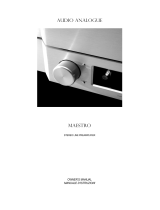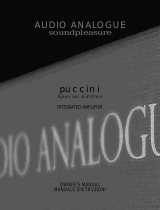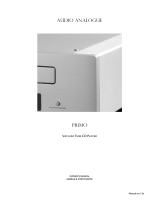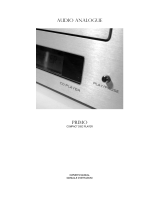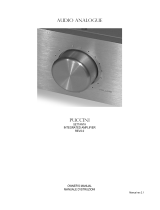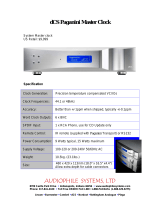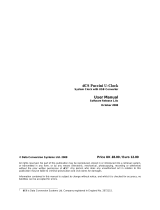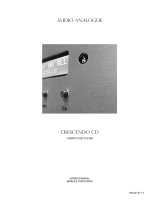Page is loading ...

AUDIO ANALOGUE
puccini
SETTANTA
INTEGRATED AMPLIFIER
REV2.0
OWNER’S MANUAL
MANUALE D’ISTRUZIONI
Manual rev.2.0c

4
INTRODUCTION
AUDIO ANALOGUE does not take any responsibilities in the following cases:
Whenever the operational procedures related to the use and the maintenance of the equipment as described in this manual are not
respected.
Whenever damages to the equipment occur because of fixing and modifications made form non-authorized staff or because of
normal deterioration of the system.
No part of this manual can be reproduced by any means, transmitted or copied for private or public use without private authorization
from AUDIO ANALOGUE.
The information contained in this manual is related to the data kept by AUDIO ANALOGUE at the moment of the issue o f this
publication; AUDIO ANALOGUE has the right to make changes to this document without prior notice.
The equipment has been projected and manufactured according to the Regulations of the Community 89/336/CEE and is marked CE.
This equipment can’t be used for different purposes other than those for which it has been manufactured.
AUDIO ANALOGUE does not take any responsibilities for accidents or damages due to improper use of the equipment.
WARNING
Please do respect the safety standards contained in this manual before starting to operate the equipment.
Do not open the equipment. No further interventions than those described in this manual should be made. For technical assistance,
please consult a qualified technician or an AUDIO ANALOGUE dealer.
Not respecting the instructions contained in this manual will invalidate the terms and conditions of the guarantee.
NECESSARY PRECAUTIONS FOR SAFETY AND MAINTENANCE
ATTENTION: before starting any operation, use or maintenance of the equipment it is strictly necessary to understand the following
manual.
To avoid any accidents or hazards it is necessary to follow the following regulations.
Activate the equipment only prior checking if the installation has been properly made, and if it is related to the instructions contained
in this manual.
Avoid installing the equipment in places subjected to extremely high temperatures or humidity.
Check that the labels containing information about safety are always visible and in good conditions.
Ensure to not obstruct ventilation, to avoid excessive overheating. The equipment should be kept to a minimal distance of 15 cm
from any object and not to place on carpet or other soft surfaces. Also the installation close to radiators or in close environments
without ventilation should be avoided.
Do not switch on the equipment until it has not been correctly and completely installed.
Only supply the equipment with the kind of the electric supply as stated on the appropriate label. If in doubts about the kind of supply
available, please consult an expert technician for technical assistance.
The equipment needs to be wired to an earth terminal. The external case is metal made; a defective connection with the earth may
be dangerous.
In case damages occurs to the supply cable, it should be immediately replaced with the same kind of cable. This operation should be
only made prior to disconnecting the main supply.
Do not place objects on the supply cable and check that this is not positioned in way through. The cable should not be knotted or
curly.
Replace the fuses always with other of the same kind.
Do not use the equipment close to the water or other liquids. If liquid entered the equipment, the plug should be disconnected from
the socket avoiding to touch the metal parts. Competent technical staff should be asked to check the equipment before operating it
again.
Do not place recipients containing liquids on the equipment. Even when it is switched off.
Keep the equipment far from sources of heat such as the solar light, kitchens, radiators etc…
Always unplug the supply cable during rainy weather.
Always Switch off and unplug the supply cable before cleaning the equipment externally.: this operation should be made using a dry
and soft cloth. Never use alcohol based cleaning material.
If the amplifier was carried from an extremely cold environment to and extremely hot one, it could create internal condensation,
causing possible bad functioning.
If this occurs, please wait for at least an hour before using it again, to allow it to gradually reach room temperature.
When not used for long periods, please unplug the equipment.
INSTRUCTIONS TO PUT IT OUT OF SERVICE
Consult qualified staff
Follow the regulations of the current legislation regarding recycling and waste disposal.

6
Front panel description
1) SELECT. Inputs selector. It allows selecting the desired source. One of the six blue leds on its right indicates the selected
source. If you press this button when the unit is in Stand-by mode, it will activate.
2) PH/1,2,3,4,5,6. Blue leds that indicate the selected input.
3) Volume knob. It rotates just for a few degrees because it operates on a switch. Do not force the knob. A slight clockwise rotation
increases the volume, a counter clockwise rotation decreases it. Attenuation level is shown by blue leds.
4) Volume leds. Sixteen blue leds around the volume knob progressively indicate the volume level.
5) IR receiver
Descrizione del pannello frontale
1) SELECT. Selettore ingressi. Permette di selezionare la sorgente da ascoltare visualizzandola tramite l’accensione uno dei sei
led blu. Quando l’apparecchio è in stand-by, la pressione di questo pulsante provoca l’attivazione dell’apparecchio.
2) PH/1, 2, 3, 4, 5, 6. Led blu per l’indicazione dell’ingresso selezionato.
3) Manopola del volume. Ruota soltanto di pochi gradi perchè realizzata con un interruttore e non deve quindi essere forzata. Una
lieve rotazione in senso orario determina l’aumento di volume, quella in senso antiorario la sua diminuzione. Il livello di
attenuazione viene visualizzato dal numero di led accesi intorno ad essa.
4) Led per l’indicazione del volume. Sedici led posti attorno alla manopola del volume, che si accendono in quantità proporzionale
al livello di attenuazione impostato.
5) Ricevitore IR.

7
Back panel description
1) RIGHT SPEAKER OUT. Right speaker out connector.
2) LEFT SPEAKER OUT. Left speaker out connector.
3) EARTH. Record player ground connector (to be used only when phono in is in use)
4) PH/1. Phono in.
5) 2,3,4,5,6. Line inputs.
6) TAPE OUT. Tape out.
7) MONO OUT. MONO Preamplifier out to connect to an active subwoofer.
8) IEC standard power inlet with main power supply switch. Connect here the supplied power cord.
9) Fuses. If necessary, replace them with others of the same kind (see back panel).
10) Main voltage switch.
Descrizione del pannello posteriore
1) RIGHT SPEAKER OUT. Connettori di uscita right.
2) LEFT SPEAKER OUT. Connettori di uscita left.
3) EARTH. Connettore per collegare il filo di terra del giradischi nel caso in cui venga utilizzato l’ingresso phono.
4) PH/1. Ingresso linea phono MM/MC.
5) 2, 3, 4, 5, 6. Ingressi linea.
6) TAPE OUT. Uscita tape.
7) MONO OUT. Uscita mono preamplificata per il collegamento ad un subwoofer attivo.
8) Presa di rete a norma IEC con interruttore di alimentazione principale. Collegare il cavo di alimentazione di rete fornito in
dotazione.
9) Fusibili. In caso di necessità ripristinare con fusibili dello stesso tipo (come indicato sul pannello posteriore).
10) Interruttore principale.

8
Remote controller description
1) “STBY”. Standby. When pressed and immediately released, it activates/deactivates standby mode.
2) “VOL+/VOL-“. Volume setting.
3) “MUTE”. Activates/deactivates muting. When muting is activated, volume level is reduced to background level and the volume
leds start blinking.
4) “IN+/IN-“. Allows source selection and navigation through the set-up.
5) “SET”. This button activates the set-up. It allows you choosing the source to by-pass.
Descrizione del telecomando
1) “STBY”. Stand-by. Attiva e disattiva lo stand-by quando viene premuto e rilasciato immediatamente.
2) “VOL+/VOL-“. Regolazione del volume.
3) “MUTE”. Attiva e disattiva il mute. Quando il muting è attivo il volume di ascolto viene ridotto ad un livello di sottofondo e i led
del volume iniziano a lampeggiare.
4) “IN+/IN-“. Seleziona la sorgente per l’ascolto e permette la navigazione nel set-up
5) “SET”. Richiama il set-up. La funzione del set up consiste nella scelta delle sorgenti di bypass.

9
Unpacking and checking Puccini Settanta package
Carefully open the package to avoid damaging the content. The package should contain:
• 1 Puccini Settanta
• 1 remote controller
• 1 power cord
• 2 AAA batteries (already placed in the remote controller)
• 1 instruction manual
If one of the items listed above is missing, please contact your Audio Analogue retailer. After extracting the smallest items from the
package, pull out the unit carefully. Separate the package from the anti-shock expanded-foam protections.
Apertura e ispezione dell’imballo
Aprire la scatola di cartone con cautela per non danneggiare il contenuto. L’imballo deve contenere:
• Un Puccini Settanta
• Un telecomando
• Due batterie AAA (già contenute nel telecomando)
• Un cavo di alimentazione
• Questo manuale
Se qualcuno degli oggetti sopra elencati dovesse mancare, contattate il Vostro rivenditore Audio Analogue di fiducia.
Dopo avere estratto le parti di minori dimensioni, estrarre con cautela l’apparecchio dall’imballo. Separare l’imballo dalle imbottiture
antiurto in schiuma espansa.
Where to place Puccini Settanta
Puccini Settanta is a complex unit that may generate a large quantity of heat. Please locate the unit in a well-ventilated place. In
particular, you should leave at least 5cm around and above the unit and avoid placing it close to heat sources (radiators, heaters,
amplifiers, television sets).
Scelta del luogo in cui posizionare il Puccini Settanta
Il Puccini Settanta è un apparecchio che può generare calore in misura non trascurabile. Per questo motivo è consigliabile
posizionarlo laddove sia garantita una corretta circolazione d’aria. In particolare, è opportuno garantire uno spazio sufficiente attorno
e sopra l’apparecchio (almeno 5cm), ed evitare posizionamenti vicino a fonti di calore (termosifoni o stufe, amplificatori di potenza,
televisori).
Plugging and connecting Puccini Settanta
Before connecting Puccini Settanta to the sources, please be sure that they’re all unplugged from wall outlets. First of all, connect
the sources to the Puccini Settanta inputs you want to use. Please use only high-quality cables with gold-plated connectors.
As the second step, connect Puccini Settanta outputs to the speakers’ cable.
At last, plug the power cord into the Puccini Settanta inlet and into the wall outlet.
Collegamento del Puccini Settanta
Prima di collegare il Puccini alle sorgenti, verificare che tutti gli apparecchi siano scollegati dalla rete elettrica.
Per prima cosa, collegare le sorgenti audio agli ingressi del Puccini Settanta che si desiderano utilizzare. Utilizzare solo cavi della
migliore qualità, terminati con connettori dorati.
Quindi, collegare le uscite del Puccini Settanta ai diffusori.
Infine, collegare il cavo di alimentazione fornito in dotazione al Puccini Settanta all’apposita vaschetta. La spina del cavo di
alimentazione andrà poi collegata ad una presa di rete.

10
SUBWOOFER
settanta
PLeft Channel
settanta
PRight Channel
settanta
PLeft Channel
settanta
PRight Channel
settanta
A) Connection with one source: example Paganini 192/24.
A) Collegamento con una sorgente: esempio Paganini 192/24.
B) Connection of an Active SUBWOOFER
B) Collegamento di un SUBWOOFER Attivo
C) Use of Bypass modality: Connection to PreAmplifier + Source (example: Bellini + Paganini 192/24)
C) Utilizzo della modalità Bypass: Collegamento ad un PreAmplificatore + Sorgente (esempio: Bellini + Paganini 192/24)
PUCCINI
settanta
Paganini 192/24
L
R
Left Out Right Out
PH 2 3 4 5 6
Back View / Visuale Posteriore
PUCCINI
settanta
Bellini
L
R
PH 2 3 4 5 6
Back View / Visuale Posteriore
Paganini 192/24
Left Out Right Out
L
R
PH /1 2 3 4 5
Left Out Right Out

11
PLeft Surround
settanta
PRight Surround
settanta
FL: Front left
FR: Front Right
LS: Left Surround
RS: Right Surround
C: Central
S: Subwoofer
Front Right
settanta
Front Left
settanta
PCentral
settanta
Subwoofer
settanta
D) Use of Bypass modality: example of connection to a system HomeTheatre 5.1
D) Utilizzo della modalità Bypass: esempio collegamento ad un impianto HomeTheatre 5.1
PUCCINI
settanta
L
R
PH 2 3 4 5 6
Back View /
Visuale Posteriore
C
FR
FL
LS RS
Video Screen
FL
FR
Multi Channel
Audio Processor + Multi
Channel Power Amplifier
Out Left Out Right
Out
SubWoofer
Pre Out
S
Out
Central

12
Phono MM/MC switchover
As said earlier the Puccini Settanta has a phono stage that interfaces both MM and MC cartridges. It is factory preset to MM, so if
switchover to MC is necessary, see the illustration for the correct jumper position. The Puccini Settanta has a Earth connection
placed in the back panel. If your turntable has a earth cable connect it to the Earth connector of the Puccini70.
Commutazione MM/MC
Come già descritto, il Puccini Settanta è dotato di uno stadio phono capace di interfacciare sia testine MM che MC. Viene fornito
regolato di fabbrica su MM, quindi se la commutazione su MC dovesse rendersi necessaria, vedere l'illustrazione per la corretta
posizione dei ponticelli. Il Puccini Settanta è dotato di collegamento di terra sul pannello posteriore. Qualora il giradischi lo possegga
collegare il cavetto di terra del giradischi al connettore di terra del Puccini 70.
Powering up Puccini Settanta
Plug the Puccini Settanta into the power outlet, and then switch-on the main power supply switch placed in the back panel, in such
way the unit enters in standby mode. When the “SELECT” button on the front panel or the “STBY” button on the remote controller is
pressed, the amplifier turns on. If nothing happens, please refer to the troubleshooting section of the present manual. Even if it is
safe to turn the unit off unplugging it from the outlet when unused for long periods of time or during lightning and electric storms, it is
possible to leave it plugged when using it daily. To this purpose, please put the unit in the Stand-by mode. Audio outs will be silenced
and the Toroidal transformer will be disconnect by the main power supply.
Accensione del Puccini Settanta
Dopo aver inserito il cavo di alimentazione di rete nella presa far commutare l’interruttore di rete posteriore, in questo modo
l’apparecchio entra automaticamente in stand by. Alla pressione del pulsante “SELECT” sul pannello frontale o del pulsante “STBY”
sul telecomando, l’apparecchio si accende. Qualora ciò non dovesse accadere, consultare la sezione dedicata alla risoluzione dei
problemi. Benché sia consigliabile spegnere completamente l’apparecchio (scollegando la spina del cavo di alimentazione di rete)
quando non viene utilizzato per lunghi periodi di tempo e comunque in occasione di temporali e tempeste elettriche, è possibile
lasciarlo acceso tra un ascolto giornaliero e l’altro. In questo caso, è disponibile la funzione di stand-by che pone l’apparecchio in
inattività, silenziando le uscite audio e staccando il trasformatore toroidale dalla rete.
Volume settings and silencing (mute)
The volume knob on the front panel and the Vol+/Vol- buttons on the remote controller change the general sound level. It means that
the volume of the two channels is altered identically. The mute buttons on the front panel and on the remote controller allows
lowering the sound level by 20dB. In normal sound level condition, it means to pass to a background music level. This function is
useful any time you have to suddenly lower the volume, for example when you answer to a phone call or when talking with people or
when changing CD in the player. When volume is very low, pressing mute button may result in totally muting the unit channels.
When the unit is muted, the volume leds will start blinking. Mute deactivating will restore the previous volume settings.
Regolazione del volume e silenziamento (mute)
La manopola del volume sul pannello frontale e i pulsanti Vol+/Vol- sul telecomando agiscono sul livello generale di ascolto. Ciò
significa che il volume di entrambi i canali viene modificato dello stesso valore.
Il pulsante di mute sul telecomando permette di attenuare il livello di ascolto di 20dB. Con un normale livello di ascolto, ciò equivale a
passare ad un livello di sottofondo musicale. Questa funzione è utile qualora sia improvvisamente necessario abbassare il volume di
ascolto, per esempio per rispondere la telefono o per parlare con qualcuno o ancora quando si desidera cambiare il CD nel lettore.

13
Per volumi molto bassi di ascolto è possibile che l’attivazione del mute provochi il silenziamento totale dei due canali. Quando
l’apparecchio è in stato di muting, i led del volume cominciano a lampeggiare. La disattivazione del mute ripristinerà comunque il
normale livello di ascolto.
Inputs selection
You may select your desired audio input by pushing the “SELECT” button on the front panel or the “IN+/IN-“ buttons on the remote
control.
Selezione dell’ingresso per l’ascolto
La selezione dell’ingresso audio desiderato per l’ascolto avviene tramite la pressione del pulsante SELECT sul pannello frontale
oppure dei pulsanti IN+ o IN- del telecomando.
Standby mode
You can put the unit in standby mode pressing either the “STBY” button on the remote controller or turning left the volume knob on
the front panel and holding it in this position for a few seconds until all the volume leds are off. When Puccini Settanta is in standby
mode, only the microcontroller section is powered while signal and power circuits are turned off, reducing power consumption and
minimizing damage risks. When the unit is in standby mode, the leds indicating the selected sources are off and the two upper
volume leds (the ones placed above the volume knob) are on.
Stand-by
L’apparecchio può essere messo in stand-by premendo il pulsante “STBY” sul telecomando oppure abbassando il volume a zero
con la manopola sul frontale e mantenendo quest’ultima ruotata verso sinistra per alcuni secondi dopo che tutti i led di indicazione
del volume si sono spenti. Quando il Puccini è in stand-by, solo il circuito di controllo rimane acceso, mentre tutti i circuiti di segnale
e di potenza sono spenti. Ciò riduce i consumi ed i rischi di danni. La condizione di stand-by è evidenziata dal fatto che tutti i led
degli ingressi sono spenti e i due led superiori dell’indicatore del volume (quelli posti esattamente sopra la manopola del volume)
sono accesi.
By-pass
The amplifier might be put in bypass mode. In this case, pre-amplifier gain is reduced to 0dB (unit gain) and you may select the input
to bypass in the set-up menu. It allows you integrating the amplifier into a multi-channel system where the unit is used to operate on
the main channels (when By-pass is activated) or using high-quality stereophonic sound source. In this case, the main channel outs
of the multi-channel processor have to be connected to the Puccini Settanta in selected for the bypassing. To select the input you
want to by-pass, hit the key SET on the remote control, select the input to by-pass and than hit SET again to confirm. To activate by-
passing it is sufficient to press the “STBY” button on the remote controller for a few seconds when the amplifier is on: on the amplifier
front panel will switch-on the led light corresponding to the by-passed input and the two led lights placed on top of volume knob. To
de-activate by-pass, hit the STBY button again on the remote control and the amplifier will go back to normal mode. Please note that
the amplifier is working when in By-pass mode. Do not keep the unit in this mode for a long time.
Warning: when unplugging the unit from the wall outlet you will lose your set-up configuration for by-pass. In this case, when Puccini
Settanta is turned on again, by-pass function will be deactivated.
By-pass
L’amplificatore può essere posto in by-pass. In questa modalità di funzionamento il guadagno del preamplificatore viene fissato a
0dB (guadagno unitario) mentre viene fissato un particolare ingresso (selezionabile dal set-up). Ciò permette di inserire il Puccini in
un impianto multicanale in cui l’apparecchio viene utilizzato per pilotare i canali principali (quando il by-pass è attivo) oppure per
ascoltare le sorgenti stereo di elevata qualità. In questo caso, le uscite dei canali principali del processore multicanale devono
essere collegate all’ingresso del Puccini selezionato per il bypass. Per selezionare l’ingresso che si vuole by-passare, premere il
tasto SET dal telecomando, selezionare l’ingresso che si vuol by-passare e confermare premendo nuovamente il tasto SET. Per
attivare il by-pass è sufficiente tenere premuto per un paio di secondi il pulsante “STBY” sul telecomando quando l’amplificatore è
attivo: sul frontale dell’amplificatore, si accenderanno il led corrispondente all’ingresso che in precedenza avevamo deciso di by-
passare ed i due led che si trovano in alto sopra la manopola del volume. Per tornare alla modalità normale premere nuovamente il
tasto STBY. Si tenga presente che nella modalità by-pass l’amplificatore è a tutti gli effetti funzionante. Evitare dunque di lasciarlo
per lungo tempo in questa modalità.
Attenzione: l’impostazione del set-up del by-pass NON viene conservata quando l’apparecchio viene scollegato dalla rete. In questo
caso, alla riaccensione del Puccini il by-pass risulterà disattivato.

14
Specifications
Parameter Measurement conditions Value
Channels: - 2
POWER
LOAD:8Ohm
LOAD:4Ohm
[email protected]%THD+N
[email protected]%THD+N
Line gain 20Hz-20kHz 12dB
Frequency response:
Attenuation –0dB
Attenuation –20dB
Attenuation –40dB
<10Hz - 140kHz +0/-3dB
<10Hz - 140kHz +0/-3dB
<10Hz - 140kHz +0/-3dB
Noise level:
Attenuation 0dB
Band limits 0Hz-48kHz
-100dB output under 1Vrms
Signal/noise ratio: 22Hz-22kHz 98dB
Power requirements: - 100V/240V 50-60Hz
Power consumption: - 350VA
Specifiche Tecniche
Parametro Condizioni di misura Valore
Numero di canali: - 2
POTENZA
Carico:8OHM
Carico:4OHM
[email protected]%THD+N
[email protected]%THD+N
Guadagno stadio linea 20Hz-20kHz 12dB
Risposta in frequenza
Attenuazione –0dB
Attenuazione –20dB
Attenuazione –40dB
<10Hz - 140kHz +0/-3dB
<10Hz - 140kHz +0/-3dB
<10Hz - 140kHz +0/-3dB
Livello di rumore
Attenuazione 0dB
Limiti di banda 0Hz-48kHz
-100dB sotto 1Vrms in uscita
Rapporto segnale/rumore 22Hz-22kHz 98dB
Alimentazione: - 100V/240V 50-60Hz
Assorbimento: - 350VA

15
Troubleshooting
Symptom Cause Remedy
Power cord incorrectly plugged
Make sure the power cord is correctly
plugged into the wall outlet
No led on
No sound
Burned-out fuses
Check fuses in the fuse panel (after
unplugging the power cord from the wall
outlet) above the IEC inlet and replace
them with new ones of the same type
Low volume Turn volume knob right
Faulty or incorrectly plugged signal
connectors between Puccini Settanta and
the sources
Check cords and their connection
Off or incorrectly selected source
Check if the source is on and active and if
it is correctly selected using the in selector
Only one in led is on
No sound
Faulty or incorrectly plugged power cords
between Puccini Settanta and the
speakers
Check cords and their connection
Selected in leds are on, volume control
works but the leds are off, or selected in
leds are off and volume leds are on
Faulty or incorrectly plugged front panel
Contact your Audio Analogue retailer for
connections check and front panel
substitution
Recording is impossible Incorrectly selected source
Select the right source using the recording
selector
No battery/ worn-out battery Place/replace battery (2 ‘AAA’ batteries)
Remote controller doesn’t work
You’re standing too far or on an exceeding
angle from the front panel
Get closer to the unit or reduce angle
If the suggested remedies should not work or the problem is not shown in the list above, please contact your local Audio
Analogue retailer.

Attention: Your product is marked with this symbol. It
means that used electrical and electronic products
should not be mixed with general household waste.
There is a collection system for these products.
Attenzione: il dispositivo è contrassegnato da questo
simbolo, che segnala di non smaltire le
apparecchiature elettriche ed elettroniche insieme ai
normali rifiuti domestici. Per tali prodotti è previsto un
sistema di raccolta a parte.
A. INFORMATION ON DISPOSAL FOR USERS (PRIVATE HOUSEHOLDS)
1 In The European Union
Attention: If you want to dispose of this equipment, please do not use the ordinary dust bin.
Used electrical and electronic equipment must be treated separately and in accordance with legislation that requires
proper treatment, recovery and recycling of used electrical and electronic equipment.
Following the implementation by member states, private households within the EU states may return their used electrical
and electronic equipment to designated collection facilities free of charge*. In some countries* your local retailer may also
take back your old product free of charge if your purchase a similar new one.
*) Please contact your authority for further details.
If your used electrical or elctronic equipment has batteries or accumulator, please dispose of these separately before and
according to local requirements.
By disposing of this product correctly you will help ensure that the waste undergoes the necessary treatment, recovery
and recycling and thus prevent potential negative effects on the environment and human health which could otherwise
arise due to inappropriate waste handling.
2. In other countries outside the EU
If you wish to discard this product, please contact your local authorities and ask for the correct method of disposal.
For Switzerland: Used electrical or electronic equipment can be returned free of charge to the dealer, even if you don’t
purchase a new product. Further collection facilities are listed on the home page of www.swisco.ch or www. Sens.ch
B. Information on Disposal for Business Users
1. In the European Union
If this product is used for business purposes and you want to discard it:
Please contact your Audio Analogue dealer who will inform you about the take-back and recycling. Small products (and
small amounts) might be taken back by your local collection facilities.
For Spain: Please contact the established collection system or your local authority foer take-back of your used products.
2. In other Countries outside the EU
If you wish to discard of this product, please contact your local authorities and ask for the current method of disposal.
A. INFORMAZIONI SULLO SMALTIMENTO PER GLI UTENTI (PRIVATI)
1 Nell’Unione europea
Attenzione: Per smaltire il presente dispositivo, non utilizzare il normale bidone della spazzatura!
Le apparecchiature elettriche ed elettroniche usate devono essere gestite a parte in conformità alla legislazione che
richiede il trattamento, il recupero e il riciclaggio adeguato dei suddetti prodotti.
In seguito alle disposizioni attuate dagli Stati membri, i privati residenti nella UE possono conferire gratuitamente le
apparecchiature elettriche ed elettroniche usate a centri di raccolta designati*.
In alcuni paesi*, anche il rivenditore locale può ritirare gratuitamente il vecchio prodotto se l’utente acquista un altro nuovo
di tipologia simile.
*) Per maggiori informazioni di prega di contattare l’autorità locale competente.
Se le apparecchiature elettriche o elettroniche usate hanno batterie o accumulatori, l’utente dovrà smaltirli a parte
preventivamente in conformità alle disposizioni locali.
Lo smaltimento corretto del presente prodotto contribuirà a garantire che i rifiuti siano sottoposti al trattamento, al
recupero e al riciclaggio necessari prevenendone il potenziale impatto negativo sull’ambiente e sulla salute umana, che
potrebbe derivare da un’inadeguata gestione dei rifiuti.
2 In paesi che non fanno parte dell’UE
Se si desidera eliminare il presente prodotto,contattare le autorità locali e informarsi sul metodo di smaltimento corretto.
Per la Svizzera: Le apparecchiature elettriche o elettroniche possono essere restituite gratuitamente al rivenditore, anche
se non si acquista un prodotto nuovo. Altri centri di raccolta sono elencati sulla homepage www.swiso.ch o di
www.sens.ch.
B. INFORMAZION SULLO SMALTIMENTO PER GLI UTENTI COMMERCIALI
1. Nell’Unione Europea
Se il prodotto è impiegato a scopi commerciali. Procedere come segue per eliminarlo.
Contattare il proprio rivenditore Audio Analogue che fornirà informazioni circa il ritiro del prodotto. Potrebbero essere
addebitate le spese di ritiro e riciclaggio. Prodotti piccoli e quantitativi ridotti potranno essere ritirati anche dai centri di
raccolta locali.
Per la Spagna: Contattare il sistema di raccolta ufficiale o l’ente locale preposto al ritiro dei prodotti usati
2. In paesi che non fanno parte dell’UE
Se si desidera eliminare il presente prodotto, contattare le autorità locali e informarsi sul metodo di smaltimento corretto.

20
Audio Analogue
Manufactured and Distributed by:
AUDIO FUTURA spa
Via Maestri Del Lavoro 583
51015 Monsummano Terme (PT) Italy
Tel. 0572 954513 fax 0572 958099
www.audioanalogue.com - info@audioanalogue.com
/

